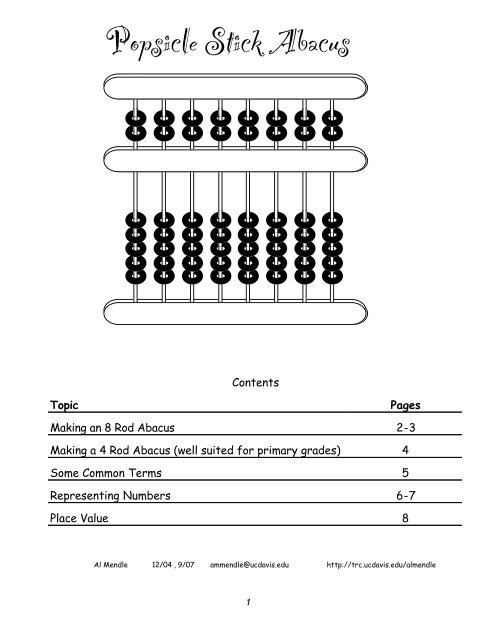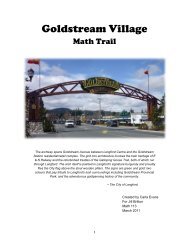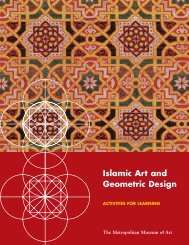Create successful ePaper yourself
Turn your PDF publications into a flip-book with our unique Google optimized e-Paper software.
<strong>Popsicle</strong> <strong>Stick</strong> <strong>Abacus</strong><br />
Contents<br />
Topic Pages<br />
Making an 8 Rod <strong>Abacus</strong> 2-3<br />
Making a 4 Rod <strong>Abacus</strong> (well suited for primary grades) 4<br />
Some Common Terms 5<br />
Representing Numbers 6-7<br />
Place Value 8<br />
Al Mendle 12/04 , 9/07 ammendle@ucdavis.edu http://trc.ucdavis.edu/almendle<br />
1
<strong>Popsicle</strong> <strong>Stick</strong> <strong>Abacus</strong> - 8 Rods<br />
For each abacus in this<br />
version, you will need:<br />
• 12 craft sticks<br />
• 8 4-inch pieces of<br />
1<br />
8 inch diameter<br />
doweling.<br />
• 56 pony beads,<br />
three different<br />
colors (21, 21, 14)<br />
• white glue<br />
−<br />
Use the grid on the<br />
right as a template.<br />
The dotted lines show<br />
where the dowels will<br />
be placed. The squiggle<br />
( ) represents glue.<br />
1. Glue two popsicle sticks together. Repeat this five more times. Place three<br />
glued pairs on top of the template, diagram 1.<br />
diagram 2<br />
Place dowels and craft sticks on top of this<br />
template<br />
2<br />
diagram 1<br />
2. Put a line of glue on top of the<br />
three popsicle stick pairs as<br />
shown in diagram 1.<br />
3. Put 7 pony beads on a piece of<br />
doweling and place on top of the<br />
template, directly above the glue,<br />
as shown in diagram 2.<br />
Al Mendle 12/04 , 9/07 ammendle@ucdavis.edu http://trc.ucdavis.edu/almendle
{<br />
select one<br />
color<br />
diagram 3<br />
{ {<br />
select a<br />
2 nd color<br />
select a<br />
3 rd color<br />
5. Glue the last three popsicle<br />
stick pairs on the top of the<br />
assembly.<br />
3<br />
4. Continue to glue the dowels<br />
with the beads as shown in<br />
diagram 3. Using differnet<br />
colors can help with place value.<br />
Be sure to use the template<br />
(diagram 1) as a guide.<br />
diagram 4<br />
The idea for this project came from a webpage entitled, “The<br />
<strong>Popsicle</strong> <strong>Stick</strong> <strong>Abacus</strong>” by Mr. Barinque. The url is:<br />
http://www.ee.ryerson.ca/~elf/abacus/popsicle/<br />
Al Mendle 12/04 , 9/07 ammendle@ucdavis.edu http://trc.ucdavis.edu/almendle
<strong>Popsicle</strong> <strong>Stick</strong> <strong>Abacus</strong> - 4 Rods<br />
For each abacus in<br />
this version, you will<br />
need:<br />
• 9 craft sticks<br />
• 4 4-inch pieces<br />
1<br />
of 8 inch<br />
diameter<br />
doweling.<br />
• 28 pony beads<br />
• white glue<br />
−<br />
Al Mendle 12/04 , 9/07 ammendle@ucdavis.edu http://trc.ucdavis.edu/almendle<br />
4<br />
Follow the same<br />
procedures shown for<br />
the 8-rod abacus.
Upper<br />
Deck<br />
{<br />
{<br />
Lower<br />
Deck<br />
Al Mendle 12/04 , 9/07 ammendle@ucdavis.edu http://trc.ucdavis.edu/almendle<br />
5<br />
} Earth<br />
Beads<br />
Reckoning Bar<br />
or Beam<br />
Rod<br />
Record the numbers represented on each abacus
Record the numbers represented on each abacus<br />
Al Mendle 12/04 , 9/07 ammendle@ucdavis.edu http://trc.ucdavis.edu/almendle<br />
6
Al Mendle 12/04, 9/07<br />
ammendle@ucdavis.edu<br />
http://trc.ucdavis.edu/almendle<br />
Shade in the beads to represent numbers.<br />
Record the values in the boxes.<br />
7
tens<br />
ones<br />
hundreds<br />
tens<br />
ones<br />
hundreds<br />
tens<br />
ones<br />
millions<br />
thousands<br />
units<br />
Use different colors of<br />
beads to represent<br />
different whole number<br />
periods.<br />
Expressing powers of 10<br />
with exponents is another<br />
nice fit.<br />
€<br />
€<br />
8<br />
thousands units decimals<br />
tens<br />
ones<br />
•<br />
10<br />
€<br />
4<br />
•<br />
10<br />
€<br />
The abacus is a natural<br />
device to amplify<br />
important place value<br />
concepts. Use it in<br />
conjunction with place<br />
value charts.<br />
hundreds<br />
tens<br />
ones<br />
tenths<br />
3<br />
•<br />
10<br />
2<br />
•<br />
€<br />
10<br />
€<br />
1<br />
•<br />
10<br />
0<br />
•<br />
€<br />
10<br />
−1<br />
•<br />
€<br />
hundredths<br />
10<br />
−2<br />
•<br />
thousandths<br />
10<br />
Using colors can also<br />
represent decimal fractions.<br />
Al Mendle 12/04. 9/07 ammendle@ucdavis.edu http://trc.ucdavis.edu/almendle<br />
−3




